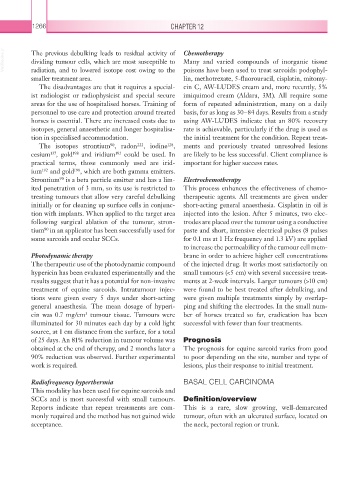Page 1291 - Equine Clinical Medicine, Surgery and Reproduction, 2nd Edition
P. 1291
1266 CHAPTER 12
VetBooks.ir The previous debulking leads to residual activity of Chemotherapy
Many and varied compounds of inorganic tissue
dividing tumour cells, which are most susceptible to
radiation, and to lowered isotope cost owing to the
smaller treatment area. poisons have been used to treat sarcoids: podophyl-
lin, methotrexate, 5-fluorouracil, cisplatin, mitomy-
The disadvantages are that it requires a special- cin C, AW-LUDES cream and, more recently, 5%
ist radiologist or radiophysicist and special secure imiquimod cream (Aldara, 3M). All require some
areas for the use of hospitalised horses. Training of form of repeated administration, many on a daily
personnel to use care and protection around treated basis, for as long as 30–84 days. Results from a study
horses is essential. There are increased costs due to using AW-LUDES indicate that an 80% recovery
isotopes, general anaesthetic and longer hospitalisa- rate is achievable, particularly if the drug is used as
tion in specialised accommodation. the initial treatment for the condition. Repeat treat-
The isotopes strontium , radon , iodine , ments and previously treated unresolved lesions
128
90
222
cesium , gold and iridium could be used. In are likely to be less successful. Client compliance is
192
198
137
practical terms, those commonly used are irid- important for higher success rates.
ium and gold , which are both gamma emitters.
192
198
Strontium is a beta particle emitter and has a lim- Electrochemotherapy
90
ited penetration of 3 mm, so its use is restricted to This process enhances the effectiveness of chemo-
treating tumours that allow very careful debulking therapeutic agents. All treatments are given under
initially or for cleaning up surface cells in conjunc- short-acting general anaesthesia. Cisplatin in oil is
tion with implants. When applied to the target area injected into the lesion. After 5 minutes, two elec-
following surgical ablation of the tumour, stron- trodes are placed over the tumour using a conductive
tium in an applicator has been successfully used for paste and short, intensive electrical pulses (8 pulses
90
some sarcoids and ocular SCCs. for 0.1 ms at 1 Hz frequency and 1.3 kV) are applied
to increase the permeability of the tumour cell mem-
Photodynamic therapy brane in order to achieve higher cell concentrations
The therapeutic use of the photodynamic compound of the injected drug. It works most satisfactorily on
hypericin has been evaluated experimentally and the small tumours (<5 cm) with several successive treat-
results suggest that it has a potential for non- invasive ments at 2-week intervals. Larger tumours (>10 cm)
treatment of equine sarcoids. Intratumour injec- were found to be best treated after debulking, and
tions were given every 5 days under short- acting were given multiple treatments simply by overlap-
general anaesthesia. The mean dosage of hyperi- ping and shifting the electrodes. In the small num-
cin was 0.7 mg/cm tumour tissue. Tumours were ber of horses treated so far, eradication has been
3
illuminated for 30 minutes each day by a cold light successful with fewer than four treatments.
source, at 1 cm distance from the surface, for a total
of 25 days. An 81% reduction in tumour volume was Prognosis
obtained at the end of therapy, and 2 months later a The prognosis for equine sarcoid varies from good
90% reduction was observed. Further experimental to poor depending on the site, number and type of
work is required. lesions, plus their response to initial treatment.
Radiofrequency hyperthermia BASAL CELL CARCINOMA
This modality has been used for equine sarcoids and
SCCs and is most successful with small tumours. Definition/overview
Reports indicate that repeat treatments are com- This is a rare, slow growing, well-demarcated
monly required and the method has not gained wide tumour, often with an ulcerated surface, located on
acceptance. the neck, pectoral region or trunk.

